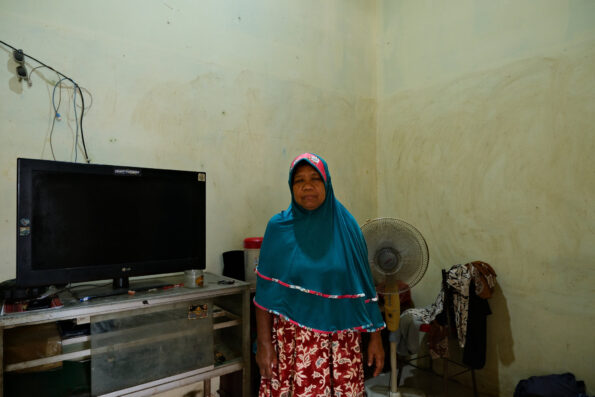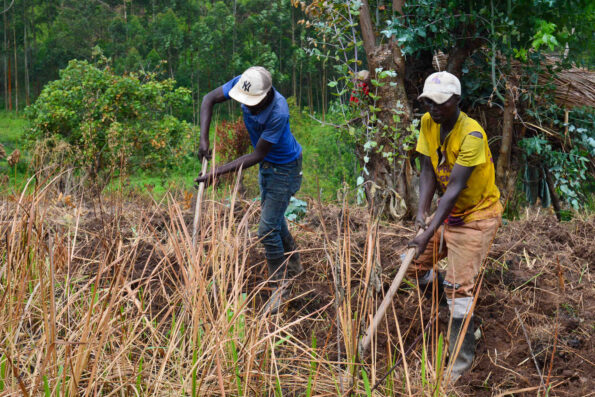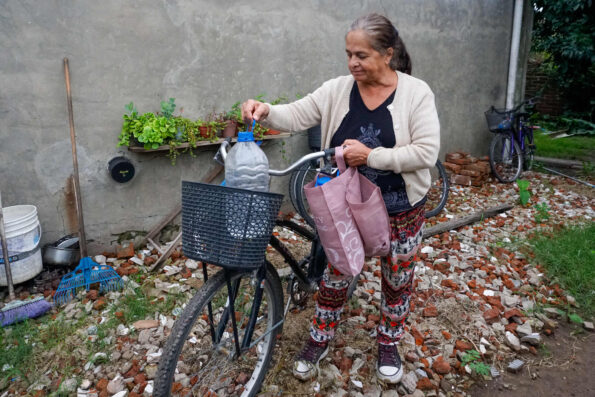
Binesikwe Means, GPJ Tribal Nations
The flags of various indigenous nations fly at Sacred Stone Camp, the site where protesters of the Dakota Access Pipeline make their home. The Standing Rock Sioux Tribe is asking nations that support its pipeline fight to divest from financial institutions that are connected to it.
MINNEAPOLIS, MINNESOTA, U.S. — The Standing Rock Sioux Tribe, which is leading the fight against an oil pipeline that members of that indigenous nation say could contaminate their drinking water, has submitted a treaty to more than 400 other indigenous nations, formally requesting that they divest from all financial institutions that have an interest in the pipeline.
The treaty, a copy of which was provided to Global Press Journal by one of its authors, was drafted in September and sent out to those indigenous nations via email and hard copy in the weeks that followed. The indigenous nations, often referred to as American Indian tribes, that received the treaty are among those that have publicly expressed support for the Standing Rock Sioux Tribe’s fight against the Dakota Access Pipeline. The Standing Rock Sioux Tribal Council voted in early October to remove all of its money from pipeline-associated financial institutions. Phyllis Young, a member of the Standing Rock Sioux Tribe who was part of the team that drafted the treaty, says that divestment process is underway.
Just one signature from another tribe would validate the treaty, Young says, but many tribes, including wealthy tribes, need to sign for it to be as effective as she hopes. So far, no tribe has publicly announced that it has signed the treaty with the Standing Rock Sioux Tribe but several have expressed interest.
There are about 560 indigenous nations formally recognized by the U.S. government. The Dakota Access Pipeline, once finished, is expected to stretch 1,172 miles and carry about 470,000 barrels of crude oil per day through North Dakota, South Dakota, Iowa and Illinois. Energy Transfer Partners, the Texas-based company that is the majority owner of the pipeline, plans to dig under the Missouri River, which is near the Standing Rock Sioux Tribe’s reservation and its historic land, including sacred sites and burial grounds.
The project cost is estimated at $3.7 billion. The many pipeline investors include Bank of America, Wells Fargo, Citibank, Goldman Sachs and JPMorgan Chase.
The Department of the Interior and the U.S. Army, in a joint statement released on Monday, announced that more discussion and analysis is needed “in light of the history of the Great Sioux Nation’s dispossessions of the lands” before construction activities approach land bordering Lake Oahe, a reservoir behind the Missouri River. The U.S. Army, representing its U.S. Army Corps of Engineers, has yet to grant easement for that construction.
The announcement is good news for the Standing Rock Sioux Tribe, but it doesn’t mean an end to its concerns.
Roots of Pipeline Opposition
The Standing Rock Sioux Tribe’s opposition to the pipeline is rooted in its status as a sovereign nation. The U.S. government signed the Treaty of Fort Laramie in 1868 with a collection of indigenous groups it called the Sioux, the name used colloquially during the pioneer era to describe the Lakota people and other groups. That treaty established the Great Sioux Reservation for those indigenous nations, land that was ultimately parceled away via federal actions, including the government’s efforts to assimilate indigenous people.
The Standing Rock Sioux Tribe is one of a handful of indigenous nations that say the 1868 treaty has been repeatedly, and sometimes violently, broken. Standing Rock leaders say the pipeline is slated to run straight through the land that was reserved for them.
The Standing Rock Sioux Tribe has led a bitter, public battle against the pipeline’s construction.
A settlement known as Sacred Stone Camp, where most protesters live in tents and other temporary structures, has developed on the banks of the Cannonball River, a tributary to the nearby Missouri River, on the northern edge of the 2.3 million-acre reservation where the indigenous nation makes its home. The size of the camp fluctuates as protesters, who call themselves “water protectors,” come and go, but its residents often number more than 1,000.
There are frequent clashes with law enforcement as protesters cross the Cannonball River to encroach upon the land controlled by the pipeline company. Law enforcement officials have used pepper spray and rubber bullets to keep the protesters at bay, and many protesters have been arrested.
The Divestment Strategy
There has been widespread support for the Standing Rock Sioux Tribe in its fight against the pipeline, but the divestment treaty asks other indigenous nations to take a concrete, if risky, step.
The indigenous nations, most of which were driven from their ancestral lands or consolidated, via a sometimes contradictory series of federal laws and actions, are largely based in rural areas where it’s difficult to spark economic growth. Tribal governments are often denied loans because banks sometimes struggle to determine the terms for lending to them, especially for loans that would ordinarily use land as collateral. There are banks that are owned by or primarily work with people in Indian Country, but they account for a very small share of the industry.
Divestment is a strategy that has worked in other scenarios. Major corporations including Coca-Cola Company divested their interests in South Africa ─ an action aimed at ending apartheid. The company returned to the country once the apartheid era ended.
Jacqueline Pata, the executive director of the National Congress of American Indians, says her organization has provided a full list of pipeline funders to the indigenous nations that have called asking for that information, but she adds that each nation must decide for itself how to proceed. Indigenous nations, historically, have had limited resources.
“It’s hard to be able to get capital in Indian Country,” she says, referring to the American Indian reservations where many indigenous nations make their homes, as well as to the economies and cultures in which indigenous nations operate. “You don’t have a bunch of choices, and that’s always been one of the challenges for Indian Country. But tribes will make those economic decisions and those social responsibility decisions and they’ll take them very seriously. Tribes have rallied in support of Standing Rock and will continue to do what they can do.”
Young of the Standing Rock Sioux Tribe acknowledges that it might be difficult to find financial institutions that are not somehow investing in the pipeline, but she says this is the start of what might become a larger movement.
“Ultimately, we have to create our own community banks,” she says.
There is no way to know the total net worth of the indigenous nations, so it’s difficult to estimate the potential impact of divestment.
“There’s a lack of data in general,” says Richard M. Todd, vice president of the Federal Reserve Bank of Minneapolis and adviser to its Center for Indian Country Development. “Part of that is on the tribal side. Given the sovereignty of tribal nations, they view their revenues and budgets as private information.”
It’s possible to collect data on how much each nation receives from the U.S. government according to individual treaties, because that federal data is in most cases publicly available. But even in those cases, total dollar amounts can be difficult to collect because grants and other benefits are recorded variably.
Many indigenous nations, including the Standing Rock Sioux Tribe, have opened casinos and other types of gaming halls on reservation land since 1988, when the Indian Gaming Regulatory Act formalized federal regulation for those businesses. That legislation led to a seismic shift for the economies of indigenous nations.
By 2015, Indian gaming revenue hit $29.9 billion, according to the National Indian Gaming Commission. In 2014, non-gaming revenue, from businesses including hotels and shopping centers often found on or near casino property, grew to an all-time high of $3.8 billion, according to a 2016 report by the Casino City Press, a leader in the publication of information on the gaming industry.
That wealth has revolutionized life for some indigenous nations. The Seminole Tribe of Florida owns the Hard Rock brand, including cafés, hotels and casinos. The Shakopee Mdewakanton Sioux Community, which owns the Mystic Lake Casino Hotel in Minnesota, reportedly gives each of its adult tribal members roughly $1 million per year.
That success has spread beyond the gaming industry. The Cherokee Nation is a major employer in Oklahoma, with about 11,000 workers in sectors including aerospace and hospitality.
Those economically successful nations are in the minority. Poverty is common in Indian Country, and many tribes have limited resources. Larry Wright Jr., chairman of the Ponca Tribe of Nebraska, says his tribal council would consider divesting in pipeline-associated banks if it received a request from the Standing Rock Sioux Tribe, but he adds that he hasn’t yet reviewed the treaty.
“I can’t say ‘No’ at this point, but I would also agree that getting capital in Indian Country and getting banks to work with our tribal sovereignty is very tough,” Wright says. “And once you have those partnerships, if it happens to be one of the big banks that has interest here, that is a very serious consideration. And for some tribes, that might change their whole financial picture. It would be tough.”
The Ponca Tribe does not have reservation land, but it is based in Nebraska near the Missouri River, and the indigenous nation’s ancestral activities revolved heavily around it, Wright says.
“We protect our sacred sites, our burial sites, our sacred places, just like Standing Rock does,” Wright says. “That’s something we can wholeheartedly get behind. God forbid if an oil spill would occur, that would affect us because we’re on the Missouri.”
Tribes far away from the Missouri River are expressing interest in divestment.
The Tlingit and Haida Indian Tribes of Alaska have sent donations to Standing Rock, and the nation’s leaders are already exploring the divestment strategy.
“[Divestment] is an agenda item for our executive council meeting,” says Grace Singh, the group’s government affairs liaison, but she adds that it hasn’t received anything from the Standing Rock Sioux Tribe.
For some economically successful tribes, divestment would mean a significant financial restructuring that would be neither straightforward nor quick.
The Tulalip Tribes of Washington, an indigenous confederation based north of the West Coast city of Seattle that owns popular casinos, a hotel, a shopping center and other attractions, would review a request that it divest from pipeline-affiliated institutions.
“We’ve always been pretty straightforward that the environment is very much a high priority,” Tulalip Tribes Chairman Mel Sheldon says.
The Tulalip Tribes government sent $10,000 to the Standing Rock Sioux Tribe to use as it sees fit, Sheldon says, and intends to continue supporting that nation’s sovereignty battle.
The Indigenous Law Institute’s Steven Newcomb, who has written widely about indigenous nations and their sovereignty, and who was part of the drafting process of Standing Rock’s divestment treaty, says of tribes that might hesitate to divest: “It all depends on their commitment.”
Additional reporting and writing by GPJ staff.







